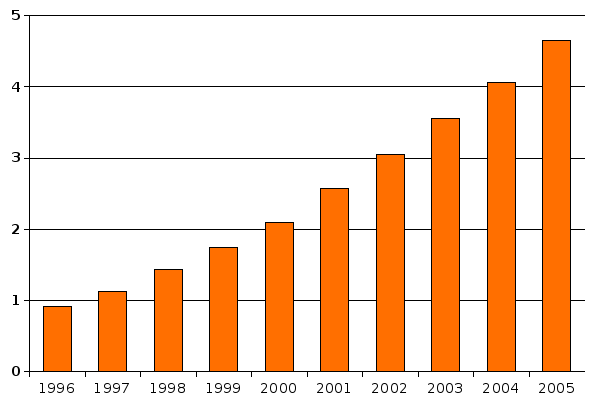Autism epidemiology and demographics
Jump to navigation
Jump to search
|
Autism Microchapters |
|
Diagnosis |
|---|
|
Treatment |
|
Case Studies |
|
Autism epidemiology and demographics On the Web |
|
American Roentgen Ray Society Images of Autism epidemiology and demographics |
|
Risk calculators and risk factors for Autism epidemiology and demographics |
Editor-In-Chief: C. Michael Gibson, M.S., M.D. [1]
Overview
Most recent reviews estimate a prevalence of 100- 200 cases per 100,000 people for autism, and about 600 per 100,000 for ASD, with ASD averaging a 4.3:1 male-to-female ratio. The number of people known to have autism has increased dramatically since the 1980s, at least partly due to changes in diagnostic practice; the question of whether actual prevalence has increased is unresolved.
Epidemiology and Demographics
Incidence
- According to National Survey of Children’s Health, by the Autism and Developmental Disabilities Monitoring (ADDM) network, the estimated annual incidence of ASD world wide is 1 child in every 110 children.[1]
- The estimated annual incidence of autism in the United states of America is similar to the world estimate, that 1 in 91 children aged 3 to 17 years.
- These numbers are similar to regional data
- In Massachusetts, the incidence of ASD in 2005 was 1 per 108 in children less than 3 years of age.
Prevalence
- The estimated annual prevalence of is 100– 200 per 100,000 for autism and close to 600 per 100,000 for ASD.[2][3]
- PDD-NOS is the vast majority of ASD, Asperger's is about 30 per 100,000 and the remaining ASD forms are much rarer.[4]

Demographics
Gender
- Males are more commonly affected by ASD than females.[5]
- The male to female ratio is approximately 4.3 to 1.
- The ASD sex ratio is greatly modified by cognitive impairment, it may be close to 2:1 with mental retardation and more than 5.5:1 for HFA.
Developed Countries
Australia
- The national estimates for the prevalence of ASD in Australia ranged from 121 to 357 per 100,000 for children aged 6–12 years.[6]
Denmark
- The annual estimate of ASD in Denamark is estimated to be 137 per 100,000.[7]
- A 2003 study reported that the cumulative incidence of autism in Denmark began a steep increase starting around 1990, and continued to grow until 2000, despite the withdrawal of thiomersal- containing vaccines in 1992.
- For example, for children aged 2–4 years, the cumulative incidence was about 5 new cases per 100,000 children in 1990 and about 45 new cases per 100,000 children in 2000.
United Kingdom
- The incidence and changes in incidence with time are unclear in the UK.[8]
- The reported autism incidence in the UK rose starting before the first introduction of the MMR vaccine in 1989.[9]
- The estimated annual incidence of ASD is 2.98 per 10,000 person.[10]
References
- ↑ Baird G, Simonoff E, Pickles A; et al. (2006). "Prevalence of disorders of the autism spectrum in a population cohort of children in South Thames: the Special Needs and Autism Project (SNAP)". Lancet. 368 (9531): 210–5. doi:10.1016/S0140-6736(06)69041-7. PMID 16844490.
- ↑ Newschaffer CJ, Croen LA, Daniels J; et al. (2007). "The epidemiology of autism spectrum disorders". Annu Rev Public Health. 28: 235–58. doi:10.1146/annurev.publhealth.28.021406.144007. PMID 17367287.
- ↑ Caronna EB, Milunsky JM, Tager-Flusberg H (2008). "Autism spectrum disorders: clinical and research frontiers". Arch Dis Child. 93 (6): 518–23. doi:10.1136/adc.2006.115337. PMID 18305076.
- ↑ Fombonne E (2005). "Epidemiology of autistic disorder and other pervasive developmental disorders". J Clin Psychiatry. 66 (Suppl 10): 3–8. PMID 16401144.
- ↑ Newschaffer CJ, Croen LA, Daniels J; et al. (2007). "The epidemiology of autism spectrum disorders". Annu Rev Public Health. 28: 235–58. doi:10.1146/annurev.publhealth.28.021406.144007. PMID 17367287.
- ↑ Williams K, Macdermott S, Ridley G, Glasson EJ, Wray JA (2008). "The prevalence of autism in Australia. Can it be established from existing data?". J Paediatr Child Health. doi:10.1111/j.1440-1754.2008.01331.x. PMID 18564076.
- ↑ Madsen KM, Lauritsen MB, Pedersen CB; et al. (2003). "Thimerosal and the occurrence of autism: negative ecological evidence from Danish population-based data". Pediatrics. 112 (3): 604–6. doi:10.1542/peds.112.3.604. PMID 12949291.
- ↑ "Incidence of autism". National Autistic Society. 2004. Retrieved 2007-12-10.
- ↑ Kaye JA, del Mar Melero-Montes M, Jick H (2001). "Mumps, measles, and rubella vaccine and the incidence of autism recorded by general practitioners: a time trend analysis". BMJ. 322 (7284): 460–3. doi:10.1136/bmj.322.7284.460. PMID 11222420.
- ↑ Smeeth L, Cook C, Fombonne E; et al. (2004). "Rate of first recorded diagnosis of autism and other pervasive developmental disorders in United Kingdom general practice, 1988 to 2001". BMC Med. 2: 39. doi:10.1186/1741-7015-2-39. PMID 15535890.